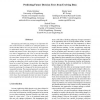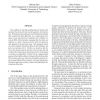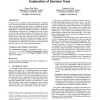EUROPAR
2007
Springer
14 years 8 months ago
2007
Springer
Selecting the close-to-optimal collective algorithm based on the parameters of the collective call at run time is an important step for achieving good performance of MPI applicatio...
ICDM
2008
IEEE
14 years 8 months ago
2008
IEEE
Recognizing and analyzing change is an important human virtue because it enables us to anticipate future scenarios and thus allows us to act pro-actively. One approach to understa...
ICDM
2008
IEEE
14 years 8 months ago
2008
IEEE
The problem of selecting small groups of itemsets that represent the data well has recently gained a lot of attention. We approach the problem by searching for the itemsets that c...
ICCD
2002
IEEE
14 years 11 months ago
2002
IEEE
VLIW processors are statically scheduled processors and their performance depends on the quality of the compiler’s scheduler. We propose a scheduling scheme where the applicatio...
KDD
2003
ACM
15 years 2 months ago
2003
ACM
Decision trees are commonly used for classification. We propose to use decision trees not just for classification but also for the wider purpose of knowledge discovery, because vi...
106
click to vote
CP
2009
Springer
15 years 2 months ago
2009
Springer
Decision tree induction techniques attempt to find small trees that fit a training set of data. This preference for smaller trees, which provides a learning bias, is often justifie...
ICML
2001
IEEE
15 years 3 months ago
2001
IEEE
ICML
2004
IEEE
15 years 3 months ago
2004
IEEE
The majority of the existing algorithms for learning decision trees are greedy--a tree is induced top-down, making locally optimal decisions at each node. In most cases, however, ...
110
click to vote
ICDE
2009
IEEE
15 years 4 months ago
2009
IEEE
Traditional decision tree classifiers work with data whose values are known and precise. We extend such classifiers to handle data with uncertain information, which originates from...
ECCV
2008
Springer
15 years 4 months ago
2008
Springer
We describe a method for implementing the evaluation and training of decision trees and forests entirely on a GPU, and show how this method can be used in the context of object rec...



